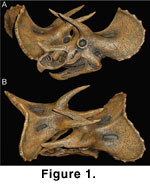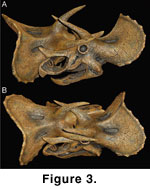RESULTS
 Three possible horn locking positions were found for the
Triceratops prorsus skull models (Figure
1, Figure 2, and Figure
3).
Three possible horn locking positions were found for the
Triceratops prorsus skull models (Figure
1, Figure 2, and Figure
3).
The first position (Figure 1), termed "single horn contact," or SHC, involved contact between only one postorbital horn of each combatant. The skulls were held roughly parallel to each other and subhorizontal, and the postorbital horns contacted each other near their bases.
 The second position (Figure
2), termed "full horn locking," or
FHL, involved contact between both postorbital horns of both combatants. The skulls were held roughly parallel to each other, at approximately 45 degrees below horizontal, and the snouts were nearly touching along their entire length. The postorbital horns contacted each other approximately one-fourth of the way up their length.
The second position (Figure
2), termed "full horn locking," or
FHL, involved contact between both postorbital horns of both combatants. The skulls were held roughly parallel to each other, at approximately 45 degrees below horizontal, and the snouts were nearly touching along their entire length. The postorbital horns contacted each other approximately one-fourth of the way up their length.
The third position (Figure
3), termed "oblique horn locking," or
OHL, also involved contact between both postorbital horns of both combatants. The skulls were held subhorizontal and roughly parallel to each other, although they were also inclined toward each other along the sagittal plane.
 Horn contact was near the base of one postorbital horn for one animal and near the tip of one horn for the other, and vice versa for the other postorbital horns.
Horn contact was near the base of one postorbital horn for one animal and near the tip of one horn for the other, and vice versa for the other postorbital horns.
These positions do not include other possible modes of horn interaction, such as positions in which the animals may have stood with skulls parallel, striking the horns together but not interlocking. Additionally, the positions cited here only reflect end members on a whole spectrum of intermediate positions.